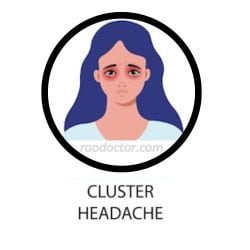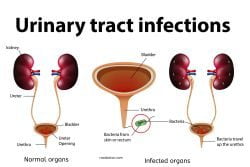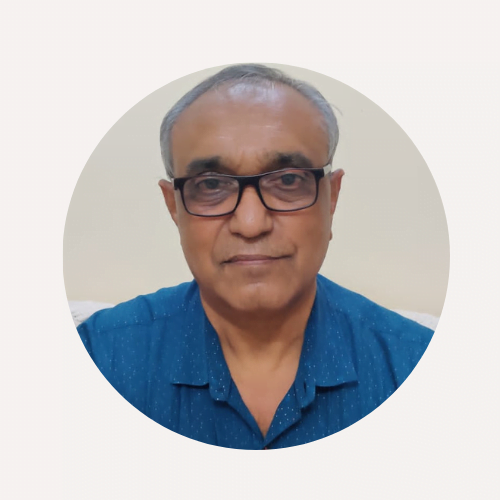
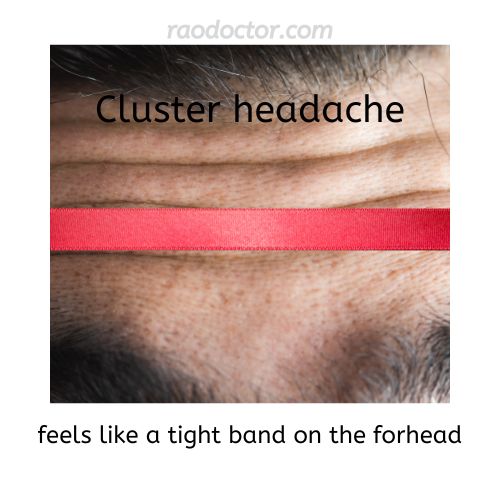
Introduction
Before we start, if you like to hear about cluster headache, listen to this audio that I have created for you-
In my last two articles on headache, I have described 2 types of headaches so far- Migraine and Tension Headache. If you have not already read it before, you can read it here below-
Listen to this blog
If you’ve ever experienced a headache so bad that you can barely see, so bad that you can barely think, and so bad that you can barely stand being in your own body…then chances are, you may have suffered from cluster headaches.
These are among the worst types of headaches anyone could ever experience; they are chronic and generally occur at the same time every day (usually in clusters).
They also tend to last longer than other types of headaches; most cluster headache attacks last between 20-180 minutes. These severe headaches usually occur on one side of the head in adults and children older than 12 years old; it is quite rare for children under 5 years old to experience them.
According to research, it affects 0.12% of the population globally. The male to female ratio is 2.5:1.
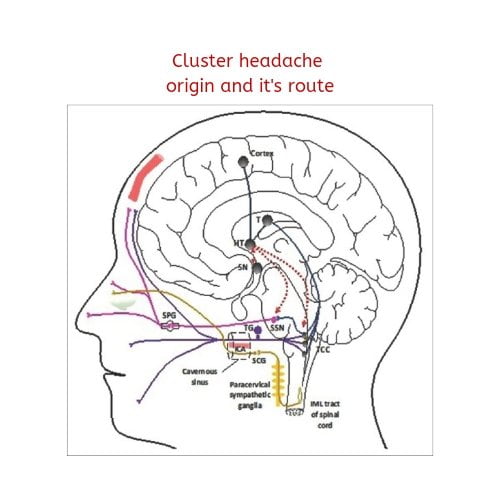
As mentioned above men are 2.5 times more likely to get cluster headaches than women. If any of these symptom’s sound like something you’ve experienced (or if you suspect that you might be suffering from them), read on for further details about cluster headache.
What are Cluster Headaches?
Cluster headaches are recurring, episodic headaches that occur in cycles. These cycles can last anywhere from a few weeks to a few years.
Cluster headaches are a result of spasms in the nerves of the face, head, and neck that cause intense pain. For most people, headaches are an occasional occurrence that is caused by things like stress, lack of sleep, or hunger.
These headaches are usually easily treatable with over-the-counter painkillers. A person who suffers from cluster headaches, however, experiences headaches much more frequently.
In fact, these headaches are so extreme that they interfere with a person’s life.
What Causes Cluster Headaches?
Unfortunately, cluster headache has no known cause. Doctors are unsure of what causes this condition, but they do know that it is not contagious.
Research shows that nerves and blood vessels in the brain act together [as shown in the diagram above] to cause this type of headache.
Cluster headaches can run in families, so if someone in your family has had them, you’re more likely to get them, too. This means that it is hereditary but, it is not a genetic disorder.
A few potential causes for cluster headaches have been explored, with varying degrees of success. While there is no certain cause for cluster headaches, researchers have explored a few potential causes.
One theory suggests that cluster headaches are caused by an increase in carbon dioxide levels in the brain, which are then followed by a decrease in oxygen levels in the brain. This reduction in oxygen levels in the brain may cause changes in the way the brain functions, resulting in headaches.
Another potential cause of cluster headaches is a change in the production of neurotransmitters (chemicals in the brain that affect mood and behavior e.g. GABA, noradrenaline).
Some research suggests that cluster headaches may be caused by irregular levels of serotonin and norepinephrine, two neurotransmitters that play a role in the regulation of pain.
Warning Signs and Symptoms of Cluster Headaches
– Intense pain. Other types of headaches may be painful, but a cluster headache is totally different. It is so intense that it may lead you to a suicide attempt.
– Unusual pain. Cluster headaches are not just above the neck. This type of headache is felt in the eyes and teeth as well. The pain is quite sharp and unbearable. It may mostly be on one side of the head. Recurrence of pain is also on the same side in most cases.
– Regularity. Each attack of pain usually occurs at the same time every day.
– Duration. The pain from a cluster headache usually lasts from one to three hours.
– Blocking of the eyes. The pain may be so bad that it will block your vision. Your eyelids may feel heavy and tend to be drooping as well as tearing.
How to Manage Your Symptoms
– Track Your Triggers. Keep a detailed log of the times when your cluster headaches are at their worst. This can help you determine what triggers your headaches.
– Keep a Medication Log. You may need to take certain medications more frequently than others during cluster periods. Keeping a log can help you avoid missing doses, which may result in inadequate treatment.
– Take a Break from Work. You should not push yourself to continue working if the headaches are very severe.
– Take a Break from School. The same advice applies if you’re a student.
– Find a Quiet Place. If the headaches are severe enough to affect your vision, you should try to find a quiet place to sit and relax.
Cluster headache treatment at home
You can try treating cluster headaches at home by using any one or more of these methods-
- – Take O2 : Administer oxygen by using a oxygen mask
– Heat. Settle into a nice, warm bath to relieve the pain of your headache.
– Ice. Put an ice pack on your head to get some quick pain relief.
– Exercise. Exercise is a great way to relieve some of the pressure of a headache, particularly if it’s a migraine.
– Medication. If you have cluster headaches, it is important to keep a supply of over-the-counter painkillers nearby. You may also want to talk to your doctor about prescription painkillers or other medications that may help.
– Sleep. A good night’s sleep is a great way to end a stressful day, and it can also help relieve a headache.
– Relaxation Techniques. Meditation and other relaxation techniques have been shown to both reduce stress and ease pain.
– Humor. Laughter has been shown to relieve pain, so find something funny and try to laugh it off. Laughter is also known as the best medicine.
–Avoid alcohol– Alcohol is known to trigger cluster headache sometimes. It would be wise to avoid having it.
Here’s an interesting quote about alcohol’s effect on headache that you should take note of
Some people spend the day complaining of a headache, and the night drinking the wine that gives it. – Johann Wolfgang von Goethe
Best medicines to prevent or treat cluster headaches
There are few drugs proven to give relief from cluster headaches. A combination of pain killers, used in treating migraines and an anti-depressant works very well to reduce or eliminate headaches.
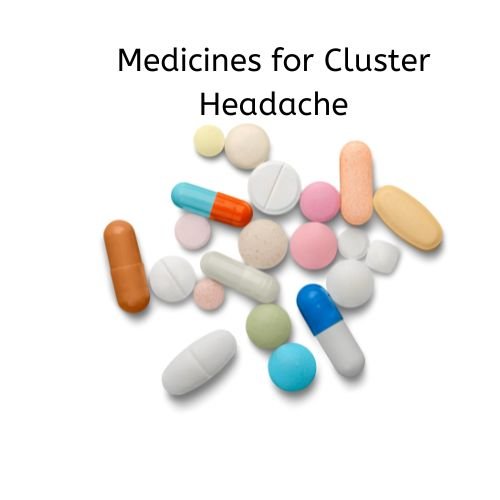
Here are the ones your doctor might prescribe-
–Triptans– Sumatriptan, a drug used to treat migraine is found to be effective in cluster headaches, especially the injectable form. e.g. Suminat
– Amitriptyline – Amitriptyline can be used to treat cluster headaches. This medication is also mostly prescribed to treat depression. E.g. Amitryn 10mg
– Carbamazepine – Carbamazepine is another medication that can be used to treat cluster headaches. This drug is often used to treat epilepsy. e.g. Tegretol 1mg
– Diazepam – Diazepam is a sedative that can help people feel relaxed and less stressed. It may also help prevent cluster headaches. e.g. Calmpose 10 mg
– Gabapentin – Gabapentin is a medication that can be used to treat cluster headaches. This drug is also sometimes prescribed to treat epilepsy. e.g. Gabapin 100 mg.
– Topiramate – Topiramate can be used to treat cluster headaches. This drug is also sometimes prescribed to treat epilepsy. e.g. Topomac 25
– Verapamil – Verapamil can be used to treat cluster headaches. This drug is sometimes prescribed to treat high blood pressure. e.g. Dilzem SR 90 mg.
If your doctor has prescribed any of these medications, you can get them online at a discount here[below]-
- Netmeds
- Tata 1mg
Final Words
Cluster headaches are among the worst types of headaches anyone could ever experience. These are recurring, episodic headaches that occur in cycles.
They are the result of spasms in the nerves of the face, head, and neck that cause intense pain. These severe headaches usually occur on one side of the head in adults and children older than 12 years old.
Women are three times more likely to get cluster headaches than men.
I hope with the information provided, you can recognize cluster headaches and consider what to do if you experience them.
Useful Resources-
Disclosure
This article contains affiliate links that may benefit the author in form of a small commission by clicking and making a purchase of items by the buyers of the item/s without any extra cost to them.
Requesting a favor from you, the reader of this article-
Dear reader, as I conclude this article, I wish to inform you that my next article will be on a much neglected yet an important topic – Worm Infestation. So, please stay tuned in.
You can receive this article in your inbox by signing up for my newsletter or commenting in the box below-
Your suggestions are important to me and are welcome.

